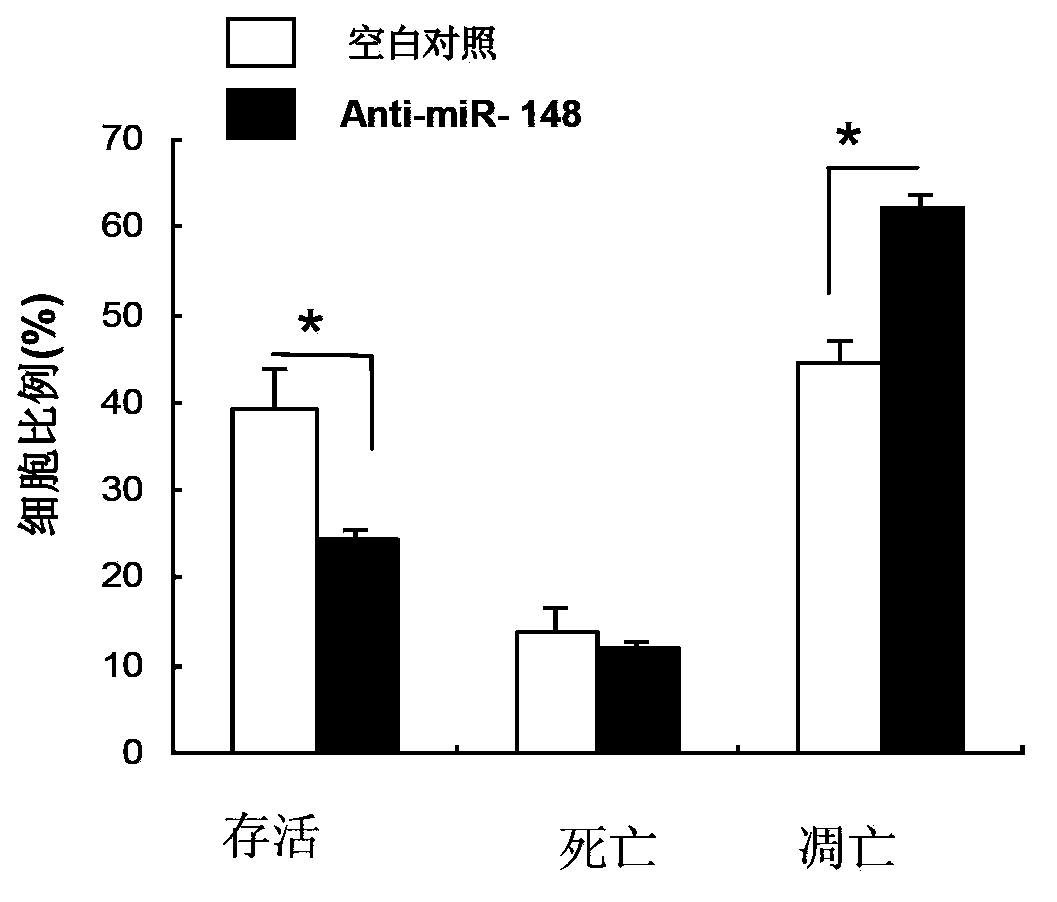Application of miR-148 to proliferation of pancreatic beta cells
1. The technology of mir-148 and β cells is applied in the direction of drug combinations, preparations for in vivo experiments, medical preparations containing active ingredients, etc., which can solve the problems of activity increase and decrease, and achieve the effect of promoting proliferation
- Summary
- Abstract
- Description
- Claims
- Application Information
AI Technical Summary
Problems solved by technology
Method used
Image
Examples
Embodiment 1
[0033] Inhibitor control and Anti-miR-148 were transiently transfected in the mouse islet β cell line MIN6, and the inhibitory efficiency was verified by Real-time PCR. It was found that the inhibitor can very effectively inhibit endogenous miR-148 in cells expression, and the degree of inhibition was more than 80%.
[0034] The 24-well plate cells and the 8-well plate slide cells were transiently transfected with blank vector inhibitor control and Anti-miR-148. 48 hours after transfection, half of the fresh culture medium was replaced, and 10mM EDU was added at a ratio of 1:1000. Incorporate cell DNA, fix the cells after 4 hours, slide the cells for EDU-Alexa647 staining, and perform flow cytometric analysis on the cells in the 24-well plate. The results showed that compared with the control group, the proportion of EDU-positive cells in the Anti-miR-148 group was significantly reduced. At the same time, the results of flow cytometry analysis also showed that the proportion o...
Embodiment 2
[0040] The isolated mouse primary islets were cultured overnight, digested and broken up, and transiently transfected with inhibitor control and Anti-miR-148. After 48 hours of transfection, the nuclei were fixed and stained. The transfection efficiency of the cells was observed under a fluorescent microscope, which was about 90%. Real-time PCR was used to verify its inhibition efficiency, and it was found that its inhibitor can very effectively inhibit the expression of endogenous miR-148 in cells, with an inhibition degree of more than 90%.
[0041] 48 hours after transfection, the results of immunofluorescence chemistry after fixation and permeabilization showed that both groups of cells had a small amount of Ki67-positive cells expressed in the nuclei. Photographs were taken under a fluorescent microscope, and statistical analysis after counting the positive cells showed that Ki67-positive cells accounted for insulin. The proportion of positive cells decreased from 9‰ to ab...
Embodiment 3
[0044] The cell line MIN6 was transiently transfected with the control blank vector and Anti-miR-148, and 48 hours after transfection, the protein kinase C inhibitor staurosprine was added at a ratio of 1:1000 to induce cell apoptosis. The cells were stained with Annexin-FITC / 7-AAD, and then analyzed by flow cytometry, the results were as follows figure 2 .
[0045]The results showed that compared with the control group, the proportion of early apoptotic cells (Annexin-FITC positive / 7-AAD negative cells) in the Anti-MiR-148 group was significantly increased, and the proportion of surviving cells (Annexin-FITC / 7-AAD negative cells ) was significantly reduced, and the proportion of dead cells or late apoptotic cells (both Annexin-FITC / 7-AAD positive cells) was not significantly changed.
[0046] Therefore, Anti-miR-148 can promote the apoptosis of the islet β-cell line MIN6, and at the same time, it indicates that the pathway of the reduction of surviving cells after inhibitin...
PUM
 Login to View More
Login to View More Abstract
Description
Claims
Application Information
 Login to View More
Login to View More - R&D
- Intellectual Property
- Life Sciences
- Materials
- Tech Scout
- Unparalleled Data Quality
- Higher Quality Content
- 60% Fewer Hallucinations
Browse by: Latest US Patents, China's latest patents, Technical Efficacy Thesaurus, Application Domain, Technology Topic, Popular Technical Reports.
© 2025 PatSnap. All rights reserved.Legal|Privacy policy|Modern Slavery Act Transparency Statement|Sitemap|About US| Contact US: help@patsnap.com



